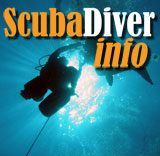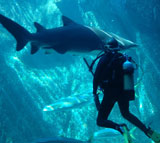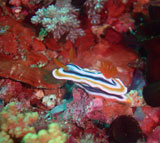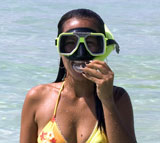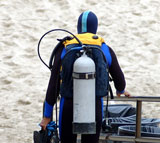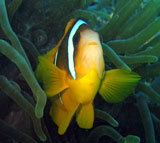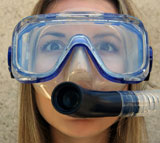This is a review and description of the seven day/seven night "liveaboard" dive trip to the Midriff islands (Islas Grandes) of the Sea of Cortez onboard the Rocio Del Mar. The trip consists of crusing to and among several of the islands and is famous for dramatic diving, swimming with whale sharks, and encountering dolphins, whales, sea lions and birds in gorgeous, unspoiled environments.
Start and end: Starts and ends at Puerto Penasco (Rocky Point) on the northern end of Baja California, Mexico. Our modified itinerary terminated at the town of Kino.
 Rocio Del Mar/Midriff islands: The Rocio Del Mar is a 110-foot long, 24-foot wide liveaboard vessel providing all-inclusive liveaboard dive vacations. There is diving at Angel island, Salsipuedes island and San Pedro Martir. Dive itineraries vary according to weather conditions, and may also include diving along Baja. The distance from Puerto Penasca to the dive sites on Angel island is about 125 miles, the distance between Angel island and Salsipuedes about 80 miles, and from there to San Pedro Martir island about 50 miles.
Rocio Del Mar/Midriff islands: The Rocio Del Mar is a 110-foot long, 24-foot wide liveaboard vessel providing all-inclusive liveaboard dive vacations. There is diving at Angel island, Salsipuedes island and San Pedro Martir. Dive itineraries vary according to weather conditions, and may also include diving along Baja. The distance from Puerto Penasca to the dive sites on Angel island is about 125 miles, the distance between Angel island and Salsipuedes about 80 miles, and from there to San Pedro Martir island about 50 miles.
The Rocio Del Mar has 10 air-conditioned staterooms for a maximum of 20-22 passengers and usually a crew of about ten, including two or three divemasters. Each room has its own bathroom and shower, the dining room on the lower deck is also air-conditioned, there is an indoor air-conditioned lounge, a covered outdoor lounge, a large sun and observation deck, food and drinks (including alcohol) are included, and depending on conditions, there will be a maximum of 24 dives on this itinerary.
Being on a liveaboard is the easiest and most relaxing way to dive because you never have to carry your gear around, and booking a trip on the Rocio Del Mar, which has served as a liveaboard dive vessel since 2008, is a great way to get in some serious, and very unique diving and exploring.
 Arrival/customs: Unlike most of our liveaboard trips, this one didn't involve a flight into a foreign country with forms and immigration and passport controls. Instead, we flew into Phoenix, had a cup of coffee and a sandwich and waited for the "Head Out To Rocky Point" shuttle to arrive to pick us up. Mike and Lynelle have been doing this shuttle service for a very long time, having been Rocky Point regulars for decades.
Arrival/customs: Unlike most of our liveaboard trips, this one didn't involve a flight into a foreign country with forms and immigration and passport controls. Instead, we flew into Phoenix, had a cup of coffee and a sandwich and waited for the "Head Out To Rocky Point" shuttle to arrive to pick us up. Mike and Lynelle have been doing this shuttle service for a very long time, having been Rocky Point regulars for decades.
Do make sure you have your reservations with them nailed down and know where to be when so as to avoid playing cellphone tag. Once we did link up, the van turned out to be large, fairly comfy and with good air conditioning. The trip from Phoenix to Rocky Point/Puerta Penasca takes about four hours, a bathroom/sandwich stop at Ajo, AZ, included. The border crossing into Mexico is a non-issue; we didn't even have to show our passports. The ride is quite scenic with lots of dramatic desert with millions of cacti, the occasional off-roaders, and it offered a chance to acquaint ourselves with some of our fellow passengers on the Rocio Del Mar to come.

Arriving at the Rocio Del Mar: liveaboards often dock in remote marinas or you have to walk a good bit with your gear to get to the boat. Not so with the Rocio Del Mar. The shuttle drives right into the thick of things and there she is, the Rocio Del Mar, at the end of a pier. Getting onboard is actually a wee bit involved; no big, comfy ramp to get onboard here. So what.


First impressions: When you first step onboard it's onto the bustling dive deck where divers assemble their gear. As always when you get on a boat you're not familiar with, it takes a bit to figure out how it all fits together. A big surprise was to see our old friend Rey, whom we knew from the Solmar V, as dive master and captain on the Rocio! In our cabin we found personalized water bottles and chocolates waiting for us. And by now the sun was setting, painting everything in magical brilliance.

Rooms: The Rocio Del Mar has ten staterooms, eight on the main deck and two on the upper deck. Each state room has large windows, making for an open, airy, light atmosphere. Cabins 1 through 6 have two single beds, cabins 7 and 8 in the front have a single large bed, and cabins 9 and 10 upstairs have a double and then a bunk bed on top. We stayed in stateroom 9 on the upper deck. All rooms are quite spacious for liveaboard standards, and there is ample drawer and storage space. There are hooks on the doors to hang a few things, there are small cubbies in the bathroom, but we missed cubbies or a small shelf next to the beds. Whatever bags and luggage you bring can either be stored in a storage compartment or, in some rooms, under the beds. There is a generous number of American-style 110 Volt outlets for electronic gear. We had no fewer than 12 plugs in our room and bathroom — perfect for those who need to charge a lot of batteries. The Rocio Del Mar allows charging of equipment in the rooms, and there are also charging stations in the library and on the dive deck for camera and strobe batteries.

Each cabin has a small but perfectly adequate bathroom with a toilet, sink and a separate shower. Fixtures, flushing and shower all worked fine and there usually was adequate hot water with good water pressure. It's probably okay to drink the water as it comes from the boat's own onboard systems, but management suggests using drinking water. The shower has a soap and shampoo dispenser, but no hair dryer. There is no minibar or safe (neither are needed as you can always get what you want from the fridge/bar, and everything is totally safe). The picture below shows one of the two forward cabins (I took the shot with permission of the guests while the cabin was in use).

The Rocio Del Mar has excellent air conditioning throughout the ship. If anything, sometimes we were almost too cold.

On a dive boat you need plenty of towels, and there is a good supply in the rooms. On the dive deck, however, you are assigned just one towel at a time and that won't be changed for three days. Towels are separated into inside and outside towels, and they are not to be mixed. Contrary to some liveaboards we've been on, you are allowed to wear shoes inside the Rocio Del Mar, and since the outside decking got quite hot, we were glad to have our Crocs with us.
The beds were comfortable though the mattresses were on the thin side (management informed us that they are replacing them with thicker and much more comfortable memory foam mattresses) and the pillows were comfortable, too. One tends to sleep well after three or four dives, and between the Rocio's inherent stability and the calm seas we had, we slept very well. The crew makes up your bed while you are diving.
Below is the deck floorplan of the Rocio Del Mar. State rooms are in blue, indoor guest common areas in yellow:

Lounge and entertainment: liveaboards aren't cruise ships, even spacious ones like the Rocio Del Mar, so there aren't any hot tubs, shops or night clubs. The purpose of the Rocio is exploring and diving, and at the end of each eventful day, we were too tired to do much but talk with new friends, gaze at the starry sky, and then retire to our cabin. The Rocio Del Mar, though, has a comfortable indoor lounge on the main deck with comfortable sofas and lounge chairs, a refrigerator with soft drinks and beer, as well as a flatscreen TV used for briefings and entertainment, a DVD player, and a sound system. There are also books, board and card games, and a large library of movie DVDs. The lounge is also where the crew served snacks and fruit platters every day.

As stated, the Rocio Del Mar has a maximum capacity of 20-22 guests, and on our trip we had a full load. On many boats this would make for a crowded feeling, but the Rocio Del Mar is more than spacious enough for everyone to be comfortable, be that in the lounge, downstairs in the dining room, or upstairs on the large sun deck. During meal times the dining room does get quite full and it can get loud in there.

The large, open top deck offers plenty of space to stretch and enjoy the sun and the views. There are lounge chairs and stargazing at night is a treat. Perhaps best of all, you never have to worry about mosquitoes or other bugs. There aren't any! There is no cover, but it's rumored the top deck will get a sun bonnet in the near future.

Crew: On our trip, we had an almost all-male crew of captains Lolo and Rey; engineer Aurelio; dive masters Mayo and Rey; chef Gerardo; and pangeros Tito, Everardo and Jorge. Co-owner Dora made a wonderful hostess. They were all exceptionally friendly, helpful and very competent. The crew provided a perfect mix of unobtrusive service and friendly interaction. They were always there, but never got in the way. Although almost the entire crew was Mexican, there was hardly any language barrier as most spoke at least passable English.

Food/Dining: Eating on the Rocio Del Mar is informal restaurant style in the dining room/lounge downstairs. There are three large table/ booths. It can get a little tight and pretty loud in there, but worked amazingly well even with our full load of guests. All food is prepared on board. The menu is posted on a white board. Special dietary requests are honored if communicated beforehand.

Breakfast consisted of early Continental-style self-serve (coffee, teas, bagels, bread, fruit, yoghurt, cereal, etc.) before the first dive, then the full breakfast around 9AM after the first dive. The full breakfast was cooked to order and we had truly excellent waffles, French toast, pan cakes, eggs any style, and sausage or bacon. The boat's coffee was good and strong, and we greatly enjoyed the lavish fruit platters.
For lunch, we saw a variety of excellent soups and bisques, chicken and beef Fajitas, hamburgers, tortillas, rice, beans, guacamole, potato salad, peppers, broiled chicken breast, tostitas, always followed by dessert (ice cream, cake, cookies, candy).
For dinner, the chef treated us to Cesar salad, lasagna, cake with chocolate sauce; pulled pork, mashed potatoes, broccoli and flan; roast beef, baked potato, vegetables, chocolate cake; fish dishes (or spaghetti and salad for those of us who considered fish friends, not food); beef fajitas, beans, rice, peppers; Hamburgers with all the condiments, etc. The food was good and plentiful, and prepared and served home-cooking rather than restaurant style.
Snacks included fruit platters, crackers, quesadillas, chicken wings, brownies, vegetables, dips, etc. Food was consistently good and plenty.

Bar/beverages: The Rocio Del Mar has a self-serve refrigerator in the main deck lounge that was always fully stocked with a variety of beer, soda cans (Coke, Coke Light, Sprite, Fanta, etc.), and bottled water. There were also a few bottles of hard liquor in the lounge (probably leftovers from the prior week's guests). At the sit-down meals, the crew served lemonade, Jamaica, water, soft drinks, and, for dinner, beer and red and white wine.
Suitability as a dive boat: The idea of a liveaboard is to make diving as easy as possible. This includes all the logistics of getting to dive sites, prepping gear, and getting in and out of the water as quickly and easily as possible. The Rocio Del Mar succeeds in almost all areas.
The covered dive prep area is on the main deck. When we first boarded we noticed that instead of the benches with the tank/BC holders and space underneath used on most dive boats, most of the Rocio's dive stations are stand-up style. Shelving for masks, snorkel and small stuff is overhead; space for fins and boots underneath. Once used to this, we quickly found that donning the BC and tank from a standing position was actually a lot easier than from a sitting position (and our backs thanked us for it!). On the main deck plan below, the dive prep and dive deck areas are marked in green:

Hanging space for wetsuits, located midship, is more than adequate and everything dried quickly. There is a large central table for cameras. There's an adequate supply of spare parts, tools, batteries and other necessities. With a full boat (20), space for divers was quite adequate and the stand-up stations worked very well.

Dive briefings are all done right on the dive deck. The crew draws maps of the dive site on a white board and uses that to explain the site and the dive plan. Divers are divided into two groups that prepare and depart on the zodiacs staggered by 15 minutes to provide each group space to spread out, each with a dive master. Divers can join the dive master, or they are free to go by themselves. Solo dives are not allowed (though some of our photographer guests did tend to split off).

Diving on the Rocio Del Mar can be either directly from the boat or from one of the two inflatables, but for the Midriff island itineraries, all dives were from the inflatables. It is a few steps down from the dive decks onto the large and sturdy dive platform at the stern of the boat. Dive staff is always there to help you put on the fins, check your air, and hand you your camera. The dive platform has two shower heads with (usually) hot water for rinsing off after dives.

Below you can see a inflatable being loaded for a dive at Angel Island. Getting into and out of the inflatable is easy (at least in the calm weather we had) due to the Rocio's very low dive deck. Initially it seemed impossible that the two inflatables could hold all the divers with all their gear. Or how one would, upon surfacing from a dive, take off the weight belt/pocket tank/BC in the water and hand it to the pangero for hefting up on the craft. Yet, it all works perfectly. Oh, and getting into the water from the inflatable requires synchronized action: One, two, three! and every second diver falls in backward together; one, two, three, and the remaining divers plunge in.


The Rocio's dive policy is a maximum depth of 130 feet. All divers are required to record their starting gas pressure before the dive and then the remaining pressure after.
Maximum dive time is 60 minutes. Divers are, of course, expected to do a three minute safety stop at 15 feet. Virtually all of our dives were just about 60 minutes.
The two showers on the dive deck (see picture below) came in handy to rinse off salt or warm up (which really wasn't necessary in the great weather we had).

Air: The boat has its own compressor system. Tanks are filled by the crew with compressor hose whips right where they are standing in their retainer rings after you take the BC/tank off after a dive. You walk down the ladder and onto the inflatable with your gear on, including tank. Upon returning to the Rocio, the crew will return your gear and tank to your dive station. All tanks are standard 80 cubic-foot aluminum cylinders with US standard Yoke valves. Tanks are in good condition and fills were always 3,000+ psi.
Nitrox: About half of the divers used nitrox, though the itinerary really doesn't make it necessary. The Rocio Del Mar offers fills of 32%, which they mix from their onboard oxygen tanks. It is each nitrox diver's responsibility to use the boat's oxygen sensor to check their nitrox, and to record oxygen percentage before each dive. Nitrox for the week costs US$120 per diver.
Weights: Lead weights are available onboard in whatever denomination you need. Ditto for weight belts.
Rental equipment: On a liveaboard, divers bring their own gear. The Rocio Del Mar, however, does have some spare parts in case someone forgets something or something breaks.
Insurance: The Rocio Del Mar requires proof of dive accident insurance.
Diving: There is surprisingly little recorded online on Midriff island diving, and that's because the upper part of the Sea of Cortez is refreshingly untouched.
So here's the big diving picture as we experienced it: diving the Midriff islands off the Rocio Del Mar is not for total beginners, but it doesn't quite require the level of experience you'll need for, say, Socorro or the Galapagos.
On our trip we had a mix of younger and older divers (ranging from 14 to 70), underwater photographers, vacationers, and even a professional breath-hold diver. Experience ranged from 50 dives to many thousands of dives.
Getting in and out of the inflatables and handling the occasional current requires a degree of physical fitness, but so does almost any type of diving. So anyone who can handle that will enjoy Midriff island diving and be treated to a wonderful variety of diving that includes pinnacles, walls, rocky slopes, sandy chutes and even caverns. Unlike Socorro with its giant mantas and sharks, the emphasis here is on an enormous variety of macro critters. Overall, those who know California Pacific diving and diving in the Caribbean will find the upper Sea of Cortez splitting the difference.
This time, our itinerary (after the news that our schedule would be altered due to an unexpected technical issue) first took us to Angel island, also known as Isla Angel de la Guarda, an uninhabited nature preserve that measures about 360 square miles and rises to 4,300 feet. It possesses a stark beauty and rock outcroppings no less dramatic than anything you might find on some famous Caribbean islands. Here we encountered 78 degree water, making me glad I had decided on bringing my 5-mil wetsuit. Visibility was less than expected and we didn't see all that much on our first one-hour dive at La Muela ("the molar"), a craggy spire poking out of the water that actually looked much like the famed Roca Partida on the Socorro itinerary. Visibility probably was much better than what it appeared, the culprit being trillions of krill, tiny crustaceans that form living clouds underwater.

Angel island has some of the most gorgeous scenery I had ever seen, totally breathtaking.

The islands in the Sea of Cortez are almost unbelievably remote and untouched. Add to that a stark beauty, stunning natural rock formations, near-geometrical lines and shapes, and underwater scenery as (or more) dramatic and stunning as those in many far more famous locations.

At Angel island we also encountered lots of sea lions. Curious pups buzzed around us during dives, occasionally reined in by a large male.

And below is a 360 degree panorama from the Rocio's sundeck anchored off Angel Island. Click on it for a much larger version.

We then left Angel island and motored down and west, into the Bahia de los Angeles, a coastal bay on the eastern shore of Baja California. The almost fully enclosed bay is part of a biosphere reserve, and we came here to see whale sharks. Whale sharks are filter feeders and the largest living fish on the planet. They can be over 40 feet in length, weigh almost 40 tons, and go back some 60 million years. They pose no danger to divers and snorkelers, and they can be observed as they are slow swimmers.
We piled into one of the Rocio's inflatables and a panga by a local operator who knows where to find the whale sharks. We found five or six of them within 15 minutes, then spent two or three hours snorkeling with these magnificent leviathans. An awesome experience! The picture below was shot with one of our GoPro cameras.

No sooner did we get back to the Rocio than hundreds of bottlenose dolphins began stampeding around the ship. They were everywhere.

We also saw a good number of pilot whales. The Rocio deployed one of its zodiacs so photographers could get a closer look.
Next came the small island of Salsipuedes that is part of the San Lorenzo Marine Archipelago National Park. Salsipuedes means "leave if you can" in Spanish, and the island looks indeed rather low and barren and nowhere near as attractive as Angel Island. There are, however, some excellent dive sites here in the form of partially or fully submerged spires.

With good visibility, the dramatic, yet surprisingly lush underwater scenery at Salsipuedes would make for perfect dives. Viz was iffy while we were there, but the dives were terrific nonetheless.

Some of the dives were shallow enough to use the waterproof cameras we had taken along. Here, Carol is snapping away with a Pentax Optio WG-II.

Below is the 360 on the island of Salsipuedes:

San Pedro Martir— even smaller than Salsipuedes (about a square mile), San Pedro Martir is in the middle of the Sea of Cortez and the southernmost of the Midriff islands. It is also officially protected as part of the Islas del Golfo de California Reserve and home to Brown and Blue-footed Boobies, sea lions, pelicans and more. Small though it is, San Pedro Martir is quite impressive. For a few years in the late 1800s, the island was used for guano mining, and you can still see some of the terraces built to catch guano.

Boobie birds are everywhere. They are clumsy and curious and not shy at all. Problem was, once they landed on a Rocio deck, they couldn't take off again and had to be herded to the back of the boat so they could jump into the water.

And below is the 360 degree panorama of San Pedro Martir island and surrounding seas from the top deck.

From San Pedro Martir, the Rocio also made an excursion to find sperm whales. Several hours looking for them proved futile, and so the ship returned to San Pedro Martir.
Below are the dive sites we visited, including my max depths on each.
Sunday, July 8, Angel Island:
- La Muela (60 feet, 63 minutes, 78F, inflatable in/back)

Monday, July 9, Angel Island:
- La Vela (90 feet, 64 minutes, 73F, inflatable in/back)
- La Vela (64 feet, 63 minutes, 77F, inflatable in/back)
- Lolo's Cove (67 feet, 64 minutes, 75F, inflatable in/back)
- Lolo's Cove night dive (skipped, inflatable in/back)
Tuesday, July 10, Baja California:
- Bahia de los Angeles (whale shark snorkeling)
- El Pescador (72 feet, 64 minutes, 77F, inflatable in/back)
- El Pescador night dive (skipped, 77F, inflatable in/back)
Wednesday, July 11, Salsipuedes island:
- Los Cuervos (89 feet, 62 minutes, 76F, inflatable in/back)
- El Caballo (91 feet, 60 minutes, 77F, inflatable in/back)
- ?? (40 feet, 63 minutes, 77F, inflatable in/back)
Thursday, July 12, San Pedro Martir island:
- El Arroyo (111 feet, 59 minutes, 79F, inflatable in/back)
- El Arroyo (51 feet, 63 minutes, 83F, inflatable in/back)
- Ravijunco (63 feet, 66 minutes, 83F, inflatable in/back)
- night dive skipped (inflatable)
Friday, July 13, San Pedro Martir island:
- Chayo's Cove (51 feet, 66 minutes, 85F, inflatable in/back)
- Chayo's Cove (105 feet, 65 minutes, 78F, inflatable in/back)
- Punta Martir (63 feet, 64 minutes, 85F, inflatable in/back)
Note that no two liveaboard trips will likely ever be the same as weather and other conditions may determine where the captain will take the boat. On our July 2012 trip we had great weather with bright sunshine and almost flat water most of the trip, but visibility was less than expected at Angel Island, adequate at Salsipuedes, and finally better at San Pedro Martir, with temperatures varying greatly, and a modified itinerary due to a hardware problem. It still turned out to be a truly memorable week of diving, stunning scenery, and unforgettable encounters.

Now here a few informational items about Rocio Del Mar trips.
Computers/Internet: There is no internet access on the boat, and even while docked in Puerto Penasco we did not detect any WiFi hotspots that could be used. The Rocio Del Mar has an onboard satellite communication system where you can, at your own cost, make calls or text. By and large, count to be totally offline while onboard (though those with Mexican cellphone service may occasionally have a signal).
Cellphones: Unless you make prior arrangement with your cellphone vendor for international coverage, you won't be able to use your phone. As soon as our shuttle made it into Mexico, I received a text from AT&T informing me that I could make calls for US$0.99/minute and could use data at the (outrageous) rate of US$19.97/megabyte.
Security: The Puerto Penasco marina is right in town and seemed secure enough. Once underway, the boat's completely safe. There is no need to lock doors or anything.
Vendors: There is no dedicated shop onboard the Rocio Del Mar. They normally, however, sell a variety of T-shirts, hats, sweat shirts, etc., but none were on board on our trip.
Weather: While generally not quite as exposed as on the open Pacific, the Rocio Del Mar takes you far out into the massive Sea of Cortez. This means that you may or may not encounter weather that can affect diving and conditions. On our trip in July of 2012, we started with hot sun in Puerto Penasco, and it was mostly hot and sunny the entire trip. It was actually a lot hotter than we had expected (usually in the 90s), and the waters were quite calm and often flat the entire trip. We never needed any of the warm top and bottoms we brought. There was, however, currents and surge on several dives. Weather conditions often dictate the itinerary and choice of dive sites when on the Rocio Del Mar.

Cost: The per person list price, based on double occupancy, for a Midriff islands dive trip on the Rocio Del Mar is US$2,295 for any of the rooms. There are no fuel surcharges or port fees. The Rocio Del Mar doesn't nickel and dime passengers, with the only extra expense the airport transfers (US$100 per person for the round trip) and $25/person for the national park. And since we drove from and to Phoenix, there is no departure tax.

Tips: Rocio Del Mar literature suggests that you're paying a tip of 10-15% of the package list price at the end of the trip. Settling the account is very informal; we simply sat down with Dora after the last night's dinner. The tip goes into a pot which will then be distributed among all crew. As always, if you're particularly pleased with someone, you can tip them separately.
Bottom Line: The 110 foot Rocio Del Mar is a liveaboard vessel specifically designed for divers. It offers week-long dive trips to the Midriff islands of the Sea of Cortez out of Puerta Penasca (Rocky Point) July through October, 9-day trips to the Socorro islands November through May out of San Jose del Cabo, and 12-day Explore Baja trips between the two itineraries. Accommodations onboard are extraordinarily spacious and comfortable for liveaboard standards. On our July 2012 Midriff islands trip, we experienced the breathtaking stark beauty of unspoiled islands, explored virtually untouched dive sites, and swam with whale sharks, sea lions and dolphins. Atmosphere is informal, food good and plentiful, crew helpful and competent. You need passable diving skills but don't have to be an expert. Nitrox certification comes in handy, but is not necessary. A wonderfully relaxing, rewarding experience.
